
|
You entered: phases
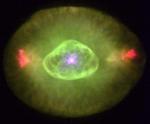 NGC 6826: The Blinking Eye
NGC 6826: The Blinking Eye
19.12.1997
The colorful planetary nebula phase of a sun-like star's life is brief. Almost in the "blink of an eye" - cosmically speaking - the star's outer layers are cast off, forming an expanding emission nebula. This nebula lasts perhaps 10 thousand years compared to a 10 billion year stellar life span.
 Lightning Eclipse from the Planet of the Goats
Lightning Eclipse from the Planet of the Goats
18.06.2011
Thunderstorms almost spoiled this view of the spectacular June 15 total lunar eclipse. Instead, storm clouds parted for 10 minutes during the total eclipse phase and lightning bolts contributed to the dramatic sky. Captured...
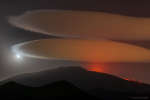 Lenticular Clouds over Mount Etna
Lenticular Clouds over Mount Etna
19.08.2019
What's happening above that volcano? Although Mount Etna is seen erupting, the clouds are not related to the eruption. They are lenticular clouds formed when moist air is forced upwards near a mountain or volcano.
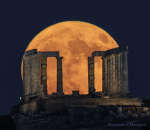 APOD: 2024 August 20 Б Supermoon Beyond the Temple of Poseidon
APOD: 2024 August 20 Б Supermoon Beyond the Temple of Poseidon
20.08.2024
A supermoon occurred yesterday. And tonight's moon should also look impressive. Supermoons appear slightly larger and brighter than most full moons because they reach their full phase when slightly nearer to the Earth -- closer than 90 percent of all full moons.
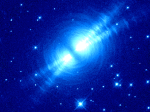 Searchlight Beams from the Egg Nebula
Searchlight Beams from the Egg Nebula
29.01.1996
The dramatic and mysterious looking object revealed in this Hubble Space Telescope image is known as the Egg Nebula. It is an aging star about 3,000 lightyears distant, entering its Planetary Nebula phase of evolution.
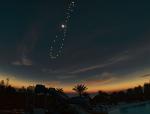 Tutulemma: Solar Eclipse Analemma
Tutulemma: Solar Eclipse Analemma
2.10.2007
If you went outside at exactly the same time every day and took a picture that included the Sun, how would the Sun appear to move? With great planning and effort, such a series of images can be taken. The figure-8 path the Sun follows over the course of a year is called an analemma.
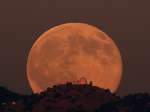 Lick Observatory Moonrise
Lick Observatory Moonrise
12.12.2008
As viewed from a well chosen location at sunset, October's gorgeous Full Moon rose behind Mount Hamilton, east of San Jose, California. Captured in this lovely telescopic view, historic Lick Observatory is perched on the mountain's 4,200 foot summit, observatory and rising Moon momentarily sharing the warm color of filtered sunlight.
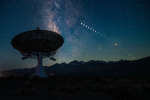 Mid Eclipse and Milky Way
Mid Eclipse and Milky Way
27.05.2021
May's perigee Full Moon slid through Earth's shadow yesterday entertaining night skygazers in regions around the Pacific. Seen from western North America, it sinks toward the rugged Sierra Nevada mountain range in this time-lapse series of the total lunar eclipse.
 Transit of Venus Stereogram
Transit of Venus Stereogram
17.07.2004
Venus glides in front of an enormous solar disk in these two frames from the TRACE satellite imaging of the inner planet's 2004 transit. Arranged in a "right/left" stereogram, the frames are intended...
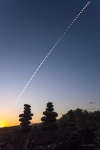 Eclipse to Sunset
Eclipse to Sunset
7.09.2016
September's eclipse of the Sun is documented in the 68 frames of this timelapse composite. Starting at 1pm local time a frame every 4 minutes follow's the progress of the New Moon across the solar disk.
|
January February March April May June July |
|||||||||||||||||||||||||||||||||||||||||||||||||